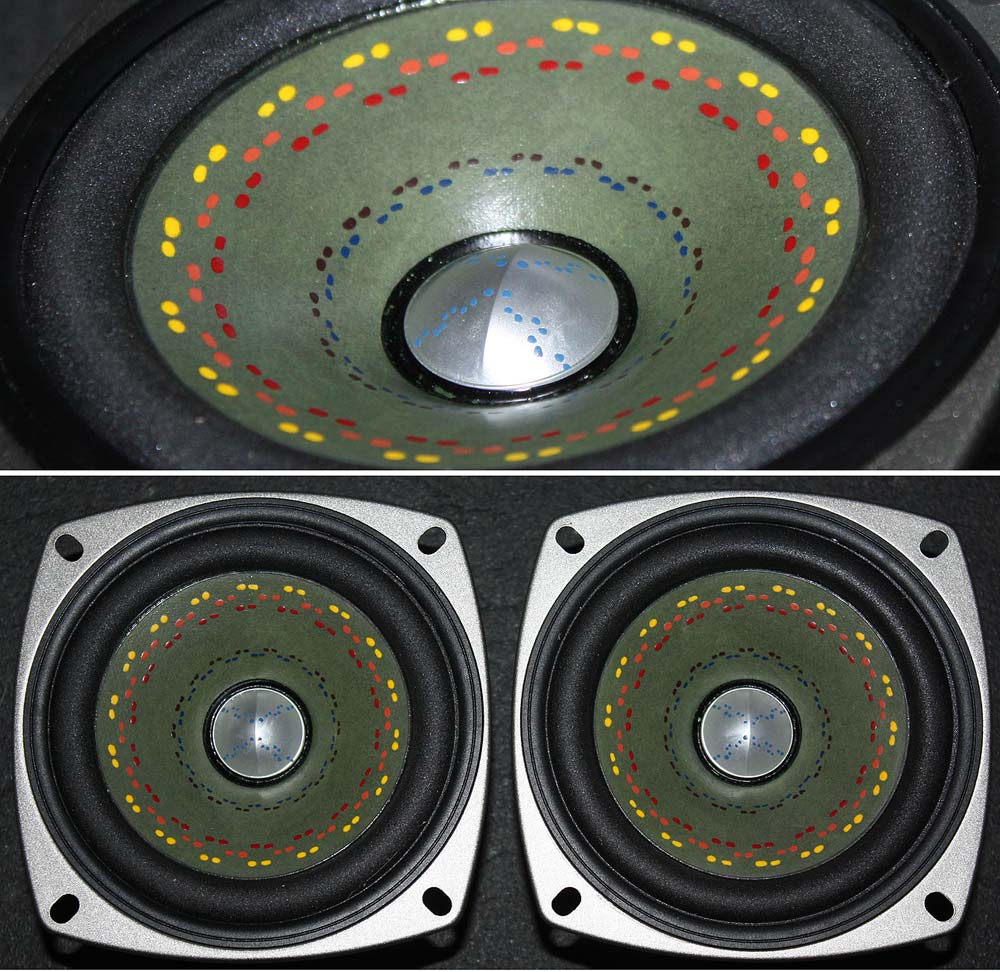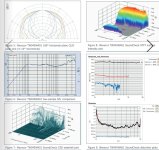..but:The off-axis response sucks. This isn’t much different from a regular-*** small wideband driver.
It’s still pretty similar and arguably a bit better while:
Having a very extended treble “top” on-axis without the treble ringing from a bell-mode(s) or substantial mechanical damping for the dust-cap.
I think at worse the power response high freq. drop-off will happen just a bit lower in freq. and be more pronounced if you listen more than about 15 degrees off-axis. Of course you can always compensate with a rear-facing super-tweeter.
a very extended treble “top” on-axis without the treble ringing from a bell-mode(s) or substantial mechanical damping for the dust-cap
These rainbow spotted FF85wKeN show the pattern of spots (and a thin coat of acrylic gloss), that along with Fostex’s stiffening crease do a decent job of keeping that under control.

The third outer ring on the cone helps with some issues at the surround/cone interface (and some ZIG 2-way on the back in the same area.
dave
I think it is an interesting driver, with serious performance. Of course it does not have the widespread applicability of a soft dome tweeter, such as a Wavecor TW030xxx series, or SB26Sxxx series, but it may be very useful in certain applications. I am in favor of any new driver which adds to our collection of driver options.
To make sure I absolutely understand what's going on here-- This is a coaxial, crossoverless, flat on-axis 1"/2" tweeter with the voicecoils wired together,
No, it looks like a cone driver with a fabric dustcap and BS-infused marketing. I guess they're stealing a page from Thiel, who called the (mediocre) widebander in their CS2.3/CS2.4 and other speakers coaxial without any basis in reality for doing so.
ScanSpeak did something similar with their 1990s-era cone midrange. IIRC it used their 38mm dome tweeter diaphragm as the dustcap. But while they noted that they didn't make nonsense claims of that midrange being a coax.
Per Voicecoil it measures exactly how one would expect resonance-riddled tweeter to measure - off-axis measurements are as bad as I've seen from a tweeter. Also, the top end is jacked up to try to compensate for the narrower directivity.
OK, to support the dismal economy and local currency I just took the June credit card repayment money and fished a pair from Idlefish Market for $175-equivalent. Maybe nine pairing candidates from 6.5" to 15", so this experiment will take all summer. At least two others on hifidiy.net just got them; it would be fun to compare notes.
Last edited:
First impressions: Sounds like what it is, ~2" ceramic cone tweeter whose "hard edge" is masked by a concentric ~1" silk dome supertweeter. Neither glassy nor soft-sounding. Response without baffle is slightly recessed above 7khz, more so beyond 10khz. Very high frequency dispersion is quite narrow at least the way I used it: 1st-order high-pass at ~7khz (7.4uF Jantzen SilverZ), above an 8" widerange that is run straight-through, flat to 5khz and 3dB less sensitive than the Wavecor. After half-a-day the sound improved noticeably, with more detail and less edge. Neutral-sounding and beginning to show realism.
(Lossless music files streamed through once-flagship phone; OCC cable; TPA3221 at 19V; cab is 17L 1.5m TLonken on loan.)
(Lossless music files streamed through once-flagship phone; OCC cable; TPA3221 at 19V; cab is 17L 1.5m TLonken on loan.)
Last edited:
Yes, I'd want 600hz at least to work with 12s.What’s the point if you can’t cross<1kHz?
dave
It's a cone tweeter, not a wide-range driver or full range. Different applications for close to the same thing. It has a Fs of 850Hz or so, an underhung Xmax of 0.75mm, and a net sensitivity of 95dB! The higher sensitivity and higher Fs relationship is not normally available in a 2" wide range due to the shift in this arrangement. Lower spl and lower Fs is normal on those types meant for a different application.
According to the Voice Coil article plots posted above, it remains below 1% at 2.2kHz+ at 130dB(!) at Vance's usual short distance which is neither close mic nearfield or farfield. As this is the case, using some creative series resistance is likely to be the case, as well as maybe an Fs comp to subdue the output as well as the self resonance. On top of this, HD will likely decrease at lower levels, and may be usable lower than my supposed 2.2k suggestion before HD sets in. Most of us do not listen louder than 85dB.
Let's take this driver for what it is, a cone tweeter. If you want to try something with it different, call or write Wavecor and OEM your own different run to your own specifications.
According to the Voice Coil article plots posted above, it remains below 1% at 2.2kHz+ at 130dB(!) at Vance's usual short distance which is neither close mic nearfield or farfield. As this is the case, using some creative series resistance is likely to be the case, as well as maybe an Fs comp to subdue the output as well as the self resonance. On top of this, HD will likely decrease at lower levels, and may be usable lower than my supposed 2.2k suggestion before HD sets in. Most of us do not listen louder than 85dB.
Let's take this driver for what it is, a cone tweeter. If you want to try something with it different, call or write Wavecor and OEM your own different run to your own specifications.
Update to #51. I ordered another set of 17L cabs, solidly built 1.8mm MDF for $25/pr, with two changes: intentionally moved the driver cutout as high as possible to be closer to outboard tweeter; unintentionally got a 3cm output slot instead of 2cm. Anyway, I proceeded to make them 1.5m TLonken much the same as the Supravox, adding automotive 3-layer antivibration pads in critical places. The output slot had to be stopped down to 2cm or (possibly better) 1.5cm to sound right. The 8" widerange driver is run straight-through (35-7khz; 50-5khz audibly flat) and is made and sold locally under the name Molisio for $50/pr. In the TLonken it goes below 40hz cleanly and with bounce and gusto. By offsetting the tweeter back 32mm (faceplate-to-faceplate) the acoustic centers are aligned, I believe, as is phase at 6.3khz nominal crossover frequency, 1st-order high-pass (1ohm->7.4uF Jantzen SilverZ) combined response ruler-straight around the crossover. The result is dynamic, "holographic" and "electrostatic". I hear more fine decernible detail than with my other speakers. After a week of fiddling, still sounded dry and a bit icy; occasionally with a ceramic "edge" but less over time. Clearly, more is needed. (Second picture Molisio reverse-polarity to align phase but not acoustic centers; not holographic.)


Last edited:
Interesting drivers.The myuaudio post is one of a series of four.
https://myuaudio.hatenablog.com/entry/2023/03/02/060000
https://myuaudio.hatenablog.com/entry/2023/03/04/060000
https://myuaudio.hatenablog.com/entry/2023/03/07/060000
https://myuaudio.hatenablog.com/entry/2023/03/10/060000
Keep in mind that when myuaudio discusses crossover frequencies for the TW045WA01, he is using it in a somewhat unusual application, as a tweeter above a Sony SUP-T11 compression driver (which has decent frequency extension for a midrange).
Hopefully driver manufacturers will make more tweeters in this direction of offering large-area diaphragms in comparison to frame size, like Accuton's C51-6-286 or this TW045WA01.
Who have heard the cone driver model "TW26K 2R" from Davis Acoustics ?
https://www.audiophonics.fr/en/tweeter/davis-acoustics-tweeter-tw26k-2r-p-7957.html
https://davis-acoustics.com/en/kevlar-series/
I think, a successor of this older DAVIS version from image in post #1 under
https://www.diyaudio.com/community/...er-overview-without-ferrofluid-wanted.161577/
My hopes were dashed at the price and low end. If these would have done 700hz at 93-95db for under 150.0 then maybe. Wavvecore has better for less $$.I'm not seeing the point of this driver
- Home
- Loudspeakers
- Multi-Way
- The return of the cone tweeter
